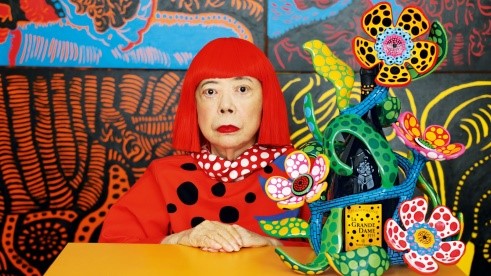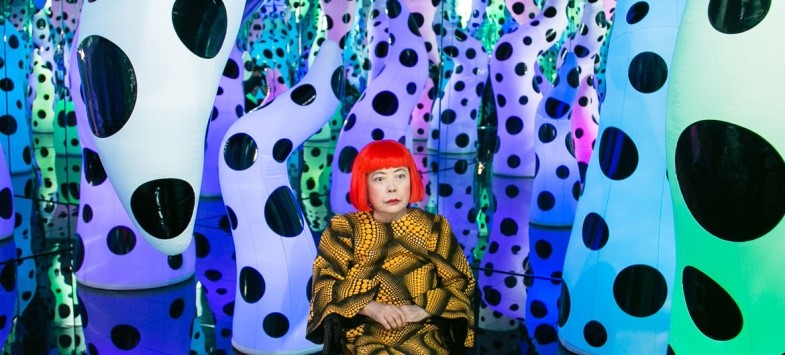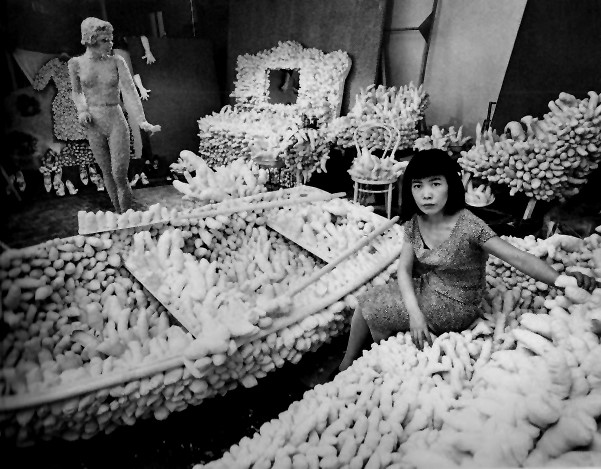You can go and see this artist’s incredibly popular mirrored infinity rooms in the Tate Modern until June 12th. That is if you can get a cancelled ticket, it is sold out. According to quite a negative two star review by Adrian Searle in the Guardian, the show is so popular you only have a few minutes each in the infinity room. In fact these shows are better than his rather cold response suggests but there is much more to this artist than mirrors and lights.
Yayoi Kusama (1929-Present) is a Japanese contemporary avant-garde artist. Her art is characterized by repetition, automatism, and obsession. Kusama is best known for her use of polka dots, pumpkin motifs, and mirrored infinity rooms. She holds the record for the second most expensive living female artist. However, there is a whole different, more radical story to be told about her artistic career.

The Boats installation reveals a lot about herself. It also shows how this woman artist pioneered two innovations in modern art:
- the repetition effect reflecting mass consumerism that Andy Warhol became famous for with his Pop Art.
- and the use of mediums like soft sculpture that another man Claes Oldenburg made his trademark style
Most people knowledgeable about art are unaware of her ground breaking contributions. Kusama’s lack of success was largely due a potent combination of sexism and racism. She was also a victim of her own integrity, as she was unwilling to create work that would have sold more easily. By 1973 Kusama was maligned by the media, depressed and destitute. She returned to Japan, and checked herself into a mental hospital in Tokyo a couple years later, where she still lives and creates today.
Kusama was forgotten until 1989, when New York’s Center for International Contemporary Arts staged a retrospective of her art. Like Frida Kahlo she has become a feminist icon.
What is the story behind the One Thousand Boats Show which became her first installation and the largest of her phallic artworks? The artist found a boat in a junkyard and lugged it on a trolley back to her studio. She describes the work like this:
The work was composed of a real rowboat covered with stuffed canvas protuberances, surrounded by 999 posters of the boat pasted on the ceiling, floor and walls of an entire room. After this show repetition became a hot theme in New York. (from the Dannywithlove blog)
Her father had been a serial womaniser and her mother has forced her to watch him with his mistresses.
When I was a child my father had lovers and I experienced seeing him. My mother sent me to spy on him. I didn’t want to have sex with anyone for years. (ibid Dannywithlove)
Aggregation: One Thousand Boats Show is the expression of Kusama’s simultaneous fear and obsession. The black wallpaper lends the impression as if the boat has been abandoned in a dark grotto, with the soft-sculptures growing like white coral on the surface. The boat sits stranded, immobilized, and unusable. The work is a psychological self-portrait. For the original unveiling, Kusama posed nude with the work, heightening the sculpture’s sexual nature.
When I saw it at the big retrospective at the Tate Modern in 2012 it was one of the stand-out works. It takes up quite a lot of space and the whiteness of the penises, their sheer number and the contrast with the dark walls and ceilings really pulls you up short. It can be shocking, even humorous, but above all it makes you think. Unlike the superficiality of a lot of Warhol’s work that reflects modern consumer society rather than criticising it Kusama shows the male sexualisation of our society. Just think of how capitalist companies use sex crudely the whole time to sell their commodities. Kusama’s work suggests that behind all the soft porn advertising there is just so much phallic power.
The sculptures clearly served as a form of aversion therapy for Kusama’s fear of the male body, dating back to the affairs of her father.
I began making penises in order to heal my feelings of disgust towards sex. (ibid)
When she worked in New York during the 60s until she left in 73 she created performance art against the Vietnam war, militarism, and Wall Street. Nudity was commonly used, it was a struggle between a cold death machine and the vibrancy of human life and sexual freedom. She dubbed them Anatomical Explosions. Today we see nudity still used in protest as we saw with Pussy Riot against Putin.

Kusama also targeted the institutional hierarchies of the art world with a nude protest in the sculpture garden at the Museum of Modern Art in New York. In 1966 at the Venice Biennale Arts exhibition she organised an installation of 1500 plastic mirror balls for the Italian pavilion.
‘Your Narcissism for Sale’ proclaimed a simple placard propped against a tree. For two dollars a passerby received a gleaming orb from the hands of the diminutive artist herself, resplendent in a silver and gold kimono. (from Mignon Nixon, Infinity Politics, 2012 Tate Exhibitin catalogue)
The Venice authorities shut her down.
As Mignon Nixon notes when considering her legacy:
Kusama ultimately ‘failed’ where Warhol prospered precisely because hers was a protest art. Remaining aloof from the contradictions his art exposed, Warhol could hardly be held responsible for them. He did not escape the 1960s unscathed, but he did emerge untarnished, and seemingly unmoved by the failure of the utopian aspirations of youth culture. Kusama’s fate was the contrary.
All her work is interesting, critical and life affirming – including the infinity mirror shows. A lot of it can be enjoyed online too. As she gets ever older the colours are not dying but getting more and more vibrant.
[The first part of this article reproduces parts of the excellent Dannywithlove blog]




